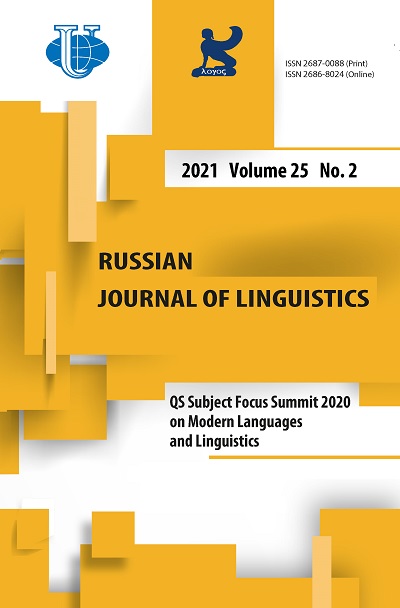Рецензия на книгу Lucia Abbamonte. 2018. Black Lives Matter. Newcastle, Cambridge Scholars Publishing. ISBN 978-1527506572
- Авторы: Понтон Д.М.1
-
Учреждения:
- Катанийский университет
- Выпуск: Том 25, № 2 (2021): QS саммит 2020 по предметным областям «Современные языки» и «Лингвистика»
- Страницы: 569-574
- Раздел: РЕЦЕНЗИИ
- URL: https://journals.rudn.ru/linguistics/article/view/26806
- DOI: https://doi.org/10.22363/2687-0088-2021-25-2-569-574
Цитировать
Полный текст
Аннотация
-
Об авторах
Дуглас Марк Понтон
Катанийский университет
Автор, ответственный за переписку.
Email: dmponton@gmail.com
ORCID iD: 0000-0002-9968-1162
доцент, преподаватель английского языка и перевода на кафедре политических и социальных наук в Катанийском университете (Италия). Сфера его научных интересов включает анализ политического дискурса, эколингвистику, социолингвистику, прикладную лингвистику, прагматику и критический дискурс-анализ. Его новейшие публикации: “For Arguments Sake: Speaker Evaluation in Modern Political Discourse” («Во имя аргументов: оценка оратора в современном политическом дискурсе») и “Understanding Political Persuasion: Linguistic and Rhetorical Aspects” («Способы убеждения в политике: лингвистические и риторические аспекты»). Наряду с политикой интересы Д.М. Понтона связаны с социальной тематикой: туризмом, дискурсом медиации, экологией, местными диалектами, народными традициями, пословицами и блюзом.
Катания, ИталияСписок литературы
- Barthes, Roland. 1973. Mythologies. Lavers, A. (trans.). London: Paladin.
- Chilton, Paul. 2004. Analyzing Political Discourse: Theory and Practise. London and New York: Routledge.
- Schäffner, Christina (ed). 1997. Analysing Political Speeches. Multilingual Matters: Clevedon.
- Fairclough, Norman. 2000. New Labour, New Language. London: Routledge.
- Fairclough, Norman & Ruth Wodak. 1997. Critical discourse analysis. In Van Dijk, Teun (ed.). Discourse Studies: A Multi-Disciplinary Introduction. Vol. I. Discourse as Structure and Process. London: Sage.
- Foucault, Michel. 1963. Naissance de la clinique: une archeologie du regard medical. Paris: Presses Universitaires de France.
- Fowler, Roger. 1991. Language in the News. London: Routledge.
- Fowler, Roger, Bob Hodge, Gunther Kress & Tony Trew. 1979. Language and Control. London: Routledge.
- Larina, Tatiana, Vladimir Ozyumenko & Douglas Ponton. 2019. Persuasion strategies in media discourse about Russia: Linguistic ambiguity and uncertainty. Lodz Papers in Pragmatics 15 (1). 3-22. DOI: https://doi.org/10.1515/lpp-2019-0002
- Martin, James. 2004. Positive discourse analysis: Solidarity and change. Revista Canaria de Estudios Ingleses 49. 179-200.
- Stibbe, Arran. 2015. Ecolinguistics: Language, Ecology and the stories We Live by. New York: Routledge.
- Van Dijk, Teun, Stella Ting-Toomey, Geneva Smitherman & Denise Troutman. 1997. Discourse, ethnicity, culture and racism. In Van Dijk, Teun (ed.). Discourse Studies: A Multidisciplinary Introduction. Vol. 2: Discourse as social interaction. London: Sage.

















